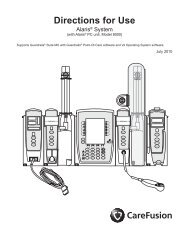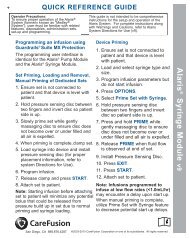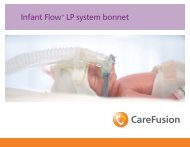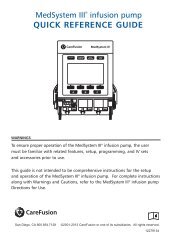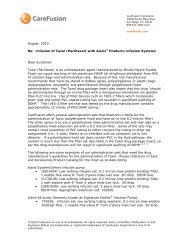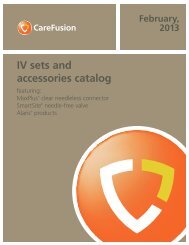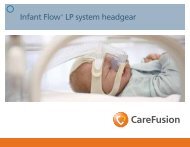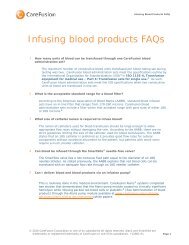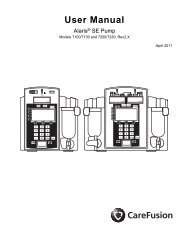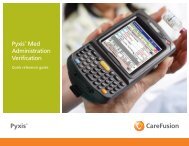Administration of blood products through the Alaris ... - CareFusion
Administration of blood products through the Alaris ... - CareFusion
Administration of blood products through the Alaris ... - CareFusion
You also want an ePaper? Increase the reach of your titles
YUMPU automatically turns print PDFs into web optimized ePapers that Google loves.
<strong>Administration</strong> <strong>of</strong> <strong>blood</strong> <strong>products</strong><br />
<strong>through</strong> <strong>the</strong> <strong>Alaris</strong> ®<br />
SE pump<br />
(Models 7100 and 7200)<br />
Rodney A. Hasler, ME<br />
Sr. Clinical Study Specialist<br />
Note: This white paper was published prior to <strong>the</strong> release <strong>of</strong> models 7130 and 7230. However, this white paper also<br />
applies to <strong>the</strong>se models as <strong>the</strong> mechanisms are identical.<br />
Summary<br />
Studies have been performed by an independent<br />
laboratory to screen for potential pump-induced<br />
hemolysis with <strong>the</strong> <strong>Alaris</strong> SE pump. These studies<br />
indicate no clinically significant hemolysis is induced by<br />
delivering <strong>blood</strong> <strong>products</strong> with an <strong>Alaris</strong> SE pump and<br />
model 72980 <strong>blood</strong> administration set or model 72023<br />
administration set. Additionally, <strong>the</strong>re did not appear to<br />
be any substantial adherence <strong>of</strong> platelets to <strong>the</strong> infusion<br />
set, nor was <strong>the</strong>re significant release <strong>of</strong> cytosolic LDH due<br />
to membrane damage.<br />
Pump assisted transfusion has become common practice.<br />
The convenience, improvement in flow rate control and<br />
volume control afforded by infusion pumps make <strong>the</strong>m<br />
an attractive alternative to pressure sleeve or gravity<br />
infusion <strong>of</strong> <strong>blood</strong> <strong>products</strong>.<br />
When IV infusion pumps are used to infuse <strong>blood</strong><br />
<strong>products</strong>, <strong>the</strong> concern most <strong>of</strong>ten expressed is whe<strong>the</strong>r<br />
passage <strong>through</strong> <strong>the</strong> pump mechanism contributes<br />
significantly to hemolysis <strong>of</strong> red <strong>blood</strong> cells. Many factors<br />
may affect hemolysis during transfusion (see Table 1).<br />
Because <strong>the</strong> influence <strong>of</strong> any combination <strong>of</strong> <strong>the</strong>se<br />
factors may converge on a given transfusion event, it<br />
has been difficult for clinicians to establish guidelines<br />
that define acceptable cell damage. For example, FDA<br />
guidelines for <strong>the</strong> evaluation <strong>of</strong> shelf life require post-<br />
transfusion survival <strong>of</strong> red cells to be only 75% <strong>of</strong> <strong>the</strong><br />
cells initially present when <strong>the</strong> unit was drawn. 1 In many<br />
instances <strong>the</strong> relationship between <strong>the</strong> amount <strong>of</strong> <strong>blood</strong><br />
product infused and <strong>the</strong> resulting clinical response is not<br />
known. Of course <strong>the</strong> clinical condition <strong>of</strong> <strong>the</strong> patient<br />
will determine individual tolerance to infusion <strong>of</strong> red cell<br />
breakdown <strong>products</strong>.<br />
There is a great deal <strong>of</strong> variation in transfusion practices<br />
among institutions. Infusion pumps do not completely<br />
automate transfusion, and are not intended to replace <strong>the</strong><br />
nurse or o<strong>the</strong>r pr<strong>of</strong>essionals in monitoring <strong>the</strong> process. For<br />
example, red cells tend to clump and settle in <strong>the</strong> <strong>blood</strong> bag<br />
prior to entering <strong>the</strong> tubing. The bag still must be mixed<br />
occasionally to resuspend <strong>the</strong> cells, as is common transfusion<br />
practice with or without pump-assisted administration.<br />
Table 1: Factors affecting hemolysis during <strong>blood</strong><br />
product transfusions<br />
Type <strong>of</strong> <strong>blood</strong> component<br />
Age <strong>of</strong> <strong>the</strong> <strong>blood</strong> product<br />
Viscosity<br />
Storage conditions (temperature, preservatives,<br />
container material)<br />
Handling (agitation, kneading to re-suspend<br />
settled cells)<br />
External pressure applied to <strong>the</strong> <strong>blood</strong> bag<br />
In-line <strong>blood</strong> filters (pore size, filter material, degree<br />
to which clots occlude surface area)<br />
Interaction between <strong>blood</strong> components and fluid path<br />
surfaces or materials<br />
Type <strong>of</strong> mechanical infusion device, if any<br />
Infusion rate<br />
Needle or ca<strong>the</strong>ter gauge
Methods<br />
P.D. Mintz, MD, Associate Pr<strong>of</strong>essor <strong>of</strong> Pathology and<br />
Internal Medicine, and G. Anderson, SBB (ASCP),<br />
University <strong>of</strong> Virginia Health Sciences Center, performed<br />
studies in 1994 on <strong>the</strong> <strong>Alaris</strong> SE pump model 7100 with<br />
model 72980 <strong>blood</strong> administration set and model 72023<br />
administration set. 2<br />
Four units <strong>of</strong> red <strong>blood</strong> cells (adenine-saline added, AS1)<br />
and four pools <strong>of</strong> platelets per set were pumped in a<br />
laboratory setting. Testing was performed at or near <strong>the</strong><br />
<strong>blood</strong> <strong>products</strong>’ outdate. To detect any red cell damage,<br />
mean corpuscular volume (MCV) was measured on<br />
each sample and RBC histograms were printed. Cell-free<br />
supernatants were prepared by double centrifugation and<br />
were measured for free hemoglobin, lactose dehydrogenase<br />
(LDH) and potassium (K+). The hematocrit <strong>of</strong> each sample<br />
was determined in order to have some measure <strong>of</strong> <strong>the</strong><br />
viscosity <strong>of</strong> <strong>the</strong> <strong>blood</strong> being pumped. Samples for each test<br />
run was collected under <strong>the</strong> five conditions in Table 2.<br />
Pooled platelets were also tested by sampling at <strong>the</strong> five<br />
conditions listed in Table 2. Platelet concentration, mean<br />
platelet volume (MPV) and percent LDH release were used<br />
as markers for platelet loss and membrane disruption.<br />
Table 2: Sampling conditions red <strong>blood</strong> cells and<br />
pooled platelets 2<br />
1. Directly from unit<br />
2. After passage <strong>through</strong> <strong>the</strong> filter and administration<br />
set by gravity alone (no pre-priming)<br />
3. After 20 mL <strong>of</strong> <strong>blood</strong>/platelets had been pumped<br />
at 999 mL/hr without a needle attached<br />
4. After 100 mL <strong>of</strong> <strong>blood</strong> (or 50 mL <strong>of</strong> platelets)<br />
had been pumped at 999 mL/hr with a 19g<br />
needle attached<br />
5. With needle attached as unit finished<br />
Results<br />
None <strong>of</strong> <strong>the</strong> assays for red cell damage displayed clinically<br />
significant differences over <strong>the</strong>ir appropriate control. For<br />
<strong>the</strong> MCV, LDH, K+ and free hemoglobin, <strong>the</strong>re were no<br />
significant differences by examination among sample means.<br />
There was one instance in which <strong>the</strong> LDH rose by 1,000 U/L<br />
and <strong>the</strong> K+ rose 12 mmol/L from <strong>the</strong> unit control to <strong>the</strong> test<br />
conditions. Since both <strong>of</strong> <strong>the</strong>se parameters were measured on<br />
<strong>the</strong> same instrument and <strong>the</strong> corresponding free hemoglobin<br />
did not increase, this isolated event is most likely a technical<br />
error in <strong>the</strong> testing (such as a dilution error). The platelet<br />
concentration, MPV and LDH release reflect no significant<br />
differences between <strong>the</strong> sample means by observation.<br />
Conclusion<br />
The <strong>Alaris</strong> SE pump with Guardrails ®<br />
s<strong>of</strong>tware has <strong>the</strong> same<br />
pumping mechanism, and <strong>the</strong>refore <strong>the</strong> same effect on <strong>blood</strong><br />
and <strong>blood</strong> hemolysis. Dr. Mintz and Mr. Anderson concluded<br />
that <strong>the</strong> <strong>Alaris</strong> SE pump, when used with model 72980 <strong>blood</strong><br />
administration set or model 72023 administration set, did not<br />
induce any clinically significant hemolysis. Additionally, <strong>the</strong>re<br />
did not appear to be any substantial adherence <strong>of</strong> platelets to<br />
<strong>the</strong> infusion set, nor was <strong>the</strong>re significant release <strong>of</strong> cytosolic<br />
LDH due to membrane damage. 2<br />
Discussion<br />
If, upon review <strong>of</strong> <strong>the</strong> study methods presented, a hospital<br />
considers its practice to be significantly different, it is<br />
recommended that <strong>the</strong> institution consider performing tests<br />
for hemolysis on a small series <strong>of</strong> outdated (worst case) <strong>blood</strong><br />
components with <strong>the</strong> complete setup and under conditions<br />
<strong>of</strong> flow rate, etc., anticipated in clinical use in <strong>the</strong> facility. The<br />
term “<strong>blood</strong> <strong>products</strong>” is not intended to be all inclusive.<br />
Special applications, such as <strong>the</strong> delivery <strong>of</strong> T-cells with <strong>the</strong><br />
<strong>Alaris</strong> SE pump, are considered unique and have not presently<br />
been studied.
References<br />
1 Walker LH. Technical manual 11th Edition. Arlington, VA: American Association <strong>of</strong><br />
Blood Banks, 1993.<br />
2 Anderson GT. Evaluation <strong>of</strong> <strong>the</strong> IVAC Signature Edition Infusion Pump to Deliver Red<br />
Blood Cells and Platelets. Transfusion, 1994, 34: 664.<br />
For product support, please contact Customer Advocacy at 888.812.3266 or email customerfeedback@carefusion.com.<br />
For technical support, please contact Instrument Technical Support at 888.812.3229.<br />
For product orders, please contact Customer Order Management at 800.482.4822.<br />
© 2010 <strong>CareFusion</strong> Corporation or one <strong>of</strong> its subsidiaries. All rights reserved. <strong>Alaris</strong> and Guardrails are<br />
trademarks or registered trademarks <strong>of</strong> <strong>CareFusion</strong> Corporation or one <strong>of</strong> its subsidiaries. IF2283 (1210/PDF)<br />
<strong>CareFusion</strong><br />
San Diego, CA<br />
carefusion.com/alaris



